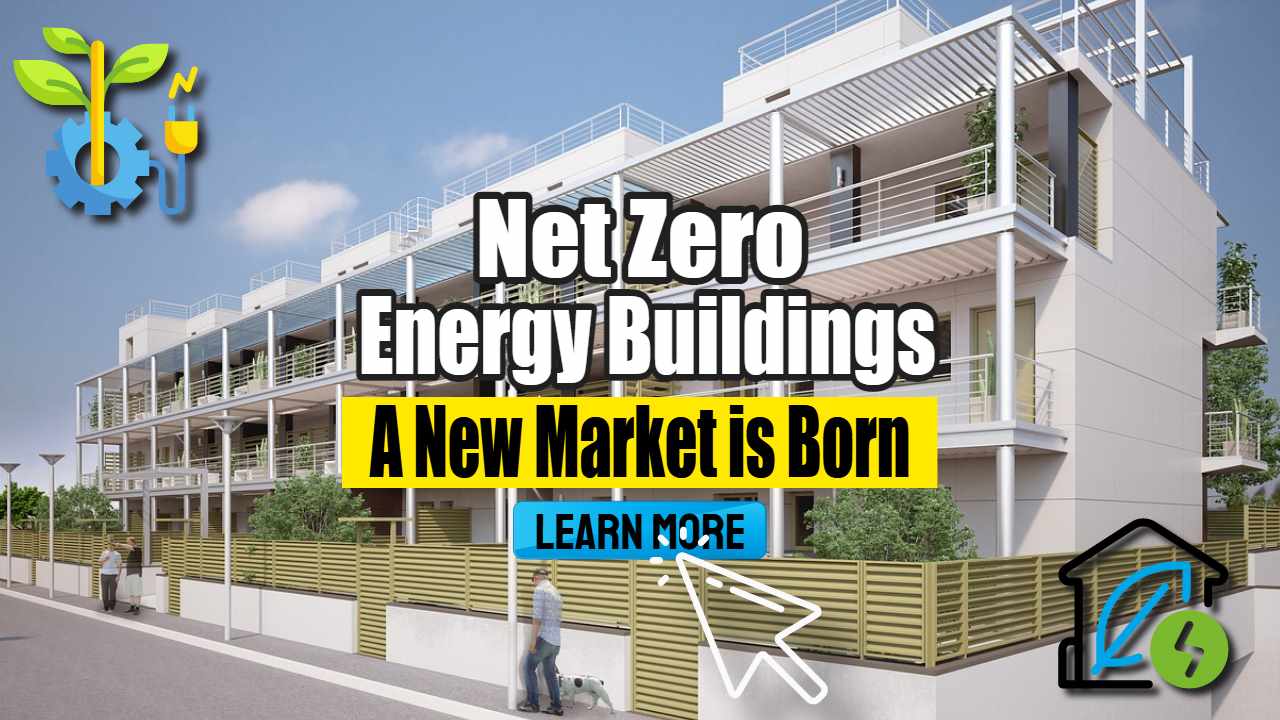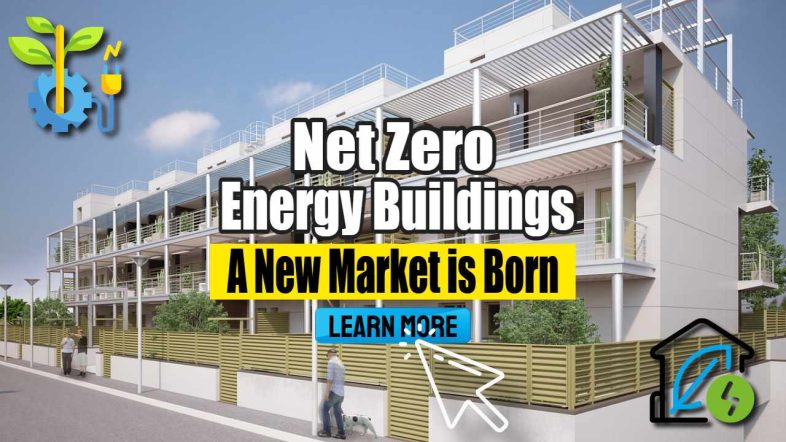Net-zero energy buildings will play a big role in curbing global warming in the decades to come.
To meet the goals of the Paris Agreement, the building sector must attain net-zero carbon by 2050.
That means billions of buildings worldwide will need to comply to keep global warming below 2° Celsius.
The building sector emits such huge amounts of greenhouse gases that urgent action is necessary to avert climate disaster.
On This Page:
- World Green Building Week and the Campaign for Net Zero Buildings
- Net Zero Buildings – what does this mean?
- Net-zero buildings: where do we stand?
- Johnson Controls Launches New Offering: Net Zero Buildings As A Service
- Net Zero Buildings Week
- Net Zero Buildings Explained
- Where do net-zero buildings make the most sense?
- Net Zero Buildings around the world
- Net Zero Buildings In North America
- Net Zero Buildings in Wisconsin
- Advanced Designs for Net Zero Buildings
- Net Zero Buildings Magazine (NZB)
- Johnson Controls Launches OpenBlue Net Zero Buildings as a Service
- Why net zero buildings?
- Powersmiths Solutions for Net Zero Buildings
- Getting Serious About Net Zero Buildings
- What Exactly Are Net Zero Buildings?
- Attributes of Net Zero Buildings
- Examples of Net Zero Buildings in Action
World Green Building Week and the Campaign for Net Zero Buildings
The World Green Building Council (WorldGBC) has welcomed 5 new additions to its net-zero carbon buildings commitment: Deloitte, Hibernia REIT plc, Lloyds Banking Group, Mace, and Watkins Payne Partnership. Cristina Gamboa, CEO of the World Green Building Council:
“It is fantastic to see stakeholders from across the built environment sector joining the net zero carbon buildings commitment.”
Buildings Commitment originates from “Advancing Net-zero,” the WorldGBC’s worldwide commitment to accelerate the uptake of net-zero-carbon buildings to 100% by 2050.
As a result, its members are leading the way in technological advancement, cutting emissions, and enhancing competitiveness – motivating others to do the same.
Countries throughout the world are gradually implementing various strategies to meet the Paris 2015 goal of net-zero greenhouse gas emissions by 2050.
Australian, Austrian, Canadian, Danish, Finnish, French, German, Italian, Republic of Korea, New Zealand and United Kingdom academics collaborated on the “Towards net-zero energy solar buildings” research initiative between 2008 and 2013.
Green Acres was the first development of several structures, residential or commercial, to achieve full zero-net energy consumption in the United States and the first zero-net energy development of single-family houses in the world, according to our knowledge.
Over 100 corporations and organisations have agreed to the World Green Construction Council’s net-zero carbon buildings pledge, which aims to decarbonize the building industry by 2050 and reach halfway there by 2030.

Net Zero Buildings – What does this mean?
We wanted to take a look at the notion of a net-zero building, which is becoming more popular, and what it may imply for the future of many commercial buildings.
Everyone’s definition of it is slightly different, as is the case with many new forms and processes of creation. Commercial construction and the construction of commercial buildings are frequently related to net-zero buildings.
Currently, 60 nations have pledged to be carbon neutral by the year 2050, according to Forbes. Net-zero buildings, according to some, might be a step in the right direction. Several nations, according to a World Resources Institute analysis, already have feasible and economical solutions in place.
There are now just a few “net-zero” buildings that are so efficient that they qualify as such.
Buildings with net-zero energy use are becoming more and more practical because of advancements in construction technology, renewable energy systems, and academic study. Even if the precise measurements for “net-zero energy” differ, most believe that net-zero energy buildings combine:
- Exemplary architectural design to reduce energy use and
- sustainable construction processes.
As far as the World Resources Institute is concerned, developing net-zero energy and net-zero energy ready buildings is a cost-effective alternative to traditional construction.
They, on the other hand, want to collect statistics on the project’s cost and performance to back up our claims.
According to statistics collected by a group of organisations including “Built Environment” and the Boston Society for Architecture (BSA/aia), creating net-zero buildings is a reality in Massachusetts today, and it is good for the economy to develop these structures.
There is a common perception that net-zero buildings are more expensive than their conventional counterparts.
Net-zero Buildings: Where do we stand?
Net-zero energy buildings produce at least as much energy as they consume on an annual basis, and these studies look at applying a similar concept at the community level.
Through energy-efficient practices and the use of alternative renewable technologies, net-zero buildings will play a key role in transitioning to a low-carbon future.
Solar energy from solar panels mounted on the building:
- decrease the carbon footprint of the building and
- increases the revenue stream by lowering utility bills.
PV arrays on rooftops etc., and tied into the electrical grid are now a standard design feature for net-zero energy construction.
Energy income from building based solar installations amounted to millions in revenue in 2018 alone. These figures might grow rapidly to hit $2. 1 billion by 2024 thanks to growing demands to reduce greenhouse gas emissions and increasing requirements for net-zero energy construction of new buildings.
Johnson Controls Launches New Offering: Net Zero Buildings As A Service
Johnson Controls, a worldwide pioneer in building management systems, has announced the availability of Openblue Net-zero Buildings as a service to assist clients in achieving their net-zero goals.
The Johnson Controls poll also showed respondents’ top five solution paths, as well as their drives for sustainability and net-zero lean towards as-a-service capabilities. Improving energy efficiency, integrating onsite renewables, electrifying building heating, incorporating offsite renewables, and adding grid-interactive capabilities will be among them.
Net Zero Buildings Week
As our worldwide society strives to meet its increasing climate responsibilities, the Leti client guide for net zero carbon buildings will assist all construction customers in navigating a fast-changing construction market. Register for the launch of the climate emergency retrofit guide here. In addition, the Leti Client Guide for net-zero carbon buildings is available.
The commitment to net-zero carbon buildings calls on the building and construction sector to take action to decarbonize the built environment, motivate others to take similar action, and eliminate implementation hurdles.
Any endeavour to decrease that consumption to zero has been viewed as a severe and unattainable goal.
However, as technology progresses and public awareness of the problems presented by climate change grows, more buildings are being constructed to consume net-zero energy, a trend that is expected to continue.
Sustainable Buildings Explained
Case studies of energy-efficient and net-zero energy buildings, with an emphasis on India, give critical insights into the concept’s viability.
Given that the idea is still in its infancy in India, it is extremely beneficial to analyse how architects and building owners have approached setting net-zero and energy efficiency targets in the selected buildings.
NBI’s getting to zero market development and leadership programme has one of the world’s most comprehensive portfolios of expertise and resources on net-zero energy and carbon-neutral buildings.
As more cities and states implement Climate Action Plans, greater emphasis will be placed on net-zero building performance as a benchmark for residential and commercial structures. There is currently a problem with conflicting terminology.
Net-zero energy buildings are referred to differently in different countries as net-zero energy, zero net energy or zero energy. While we strive for consistency, we also want to utilise terminology that reflects local preferences.
Where do Net-zero buildings make the most sense?
A few initiatives encourage the construction of zero-carbon buildings, which release no net carbon over the course of a year.
To significantly cut greenhouse gas emissions, the United States must construct new houses and structures that use less energy and emit less pollution. As a result, zero-energy or near-zero-energy building must begin as soon as humanly possible.
These case studies, which include zero and near-zero net energy buildings that have been freshly constructed or converted, are intended to enlighten and inspire you to contemplate what is possible.
Sustainable Buildings around the world
The WorldGBC has set a highly ambitious aim in this regard: all newly constructed buildings must function with zero carbon emissions beginning in 2030. Furthermore, by 2050, all buildings must be zero-carbon in operation.
Net-zero is a concept that is most usually associated with commercial buildings, however any livable structure can be a net-zero construction.
As a result, net-zero buildings (or Zero net Energy – ZNE Structures) emit fewer greenhouse gases into the environment than comparable non-ZNE buildings. They do consume nonrenewable energy and emit greenhouse gases at times, but they also cut energy consumption and greenhouse gas emissions elsewhere by the same amount.
The majority of zero net energy buildings receive 50% or more of their energy from the grid and return the same amount at other times.
Buildings that produce an excess of energy over the course of the year may be referred to as “Buildings that consume slightly more energy than they produce are referred to as “energy-plus buildings,” and buildings that consume slightly more energy than they produce are referred to as “near-zero energy buildings” or “ultra-low energy houses.”
In an interview first published by Arup’s newly relaunched online magazine Arup Doggerel as “Sarah Wesseler of net-zero learning talks to Morphosis, Arup, and Cornell team members about how they constructed a case study facility to be one of the most sustainable education facilities in the world.
Net Zero Buildings In North America
Climate risk is generally acknowledged as a financial concern by building owners and operators across North America.
As a result, between 2019 and 2020, the number of organisations with enterprise facilities, developers, and building owners and operators committed to net zero emissions more than quadrupled.
The new buildings institute’s getting to zero buildings database has a comprehensive list of initiatives throughout North America.
Any net-zero building, like the related objective of establishing a carbon-neutral building, must first accomplish considerable load reductions and system efficiency before meeting the residual loads with onsite energy generation.
Net Zero Buildings in Wisconsin
One increasingly popular method is the design of net-zero-energy buildings, which architects may begin adopting in ground-up residential projects and retrofits rather fast.
But where to begin? There’s a lot of jargon around net-zero-energy buildings, but here’s the simplest definition: a net-zero house generates as much power on-site as it consumes in a year.
The following is an edited excerpt from Brad Liljequist’s book “the power of zero: learning from the world’s leading net-zero energy buildings” (International Living Future Institute, 2010).
In simpler terms, net-zero energy buildings and communities produce as much energy as they consume over the course of a year.
The vast majority of NZE buildings are grid-connected, with a metre that rotates backwards and forwards: when the building generates more than it consumes, it creates a surplus; when it consumes more than it generates, it draws from that surplus.
At the end of the year, it nets to zero or is potentially a net positive.
Advanced Designs for Net Zero Buildings
While many previously considered that net-zero carbon buildings could only be achieved by technologically sophisticated or rich countries, the Water Research Institute’s analysis provides a menu of net-zero carbon building policy approaches. These paths are built on wide criteria and uncover numerous paths that are already feasible today, even in unexpected places.
Professional engineers and architects who desire to broaden their expertise to encompass the design, construction and operation of zero energy (net zero) buildings can enrol in an advanced course.
Net Zero Buildings Magazine (NZB)
Net-zero Buildings Magazine (NZB) serves to assist owners and architects in adjusting to the zero-energy paradigm by providing practical applications, methods, protocols, and product offers that aid in project success.
Why net zero buildings?
Building performance is defined by numerous criteria, including net-zero site energy buildings, net-zero source energy buildings, net-zero energy cost buildings, and net-zero energy emission buildings.
Finally, net-zero energy emission buildings are those that examine the emissions created by the building’s energy requirements.
We are guiding early adopters in the building industry toward – or beyond – net-zero energy by working with individual buildings, cities, districts, and portfolios to significantly reduce energy use and power them with cost-effective renewable energy sources while also supporting a dynamic grid interface.
Powersmiths Solutions for Net Zero Buildings
The net-zero movement is propelled by innovation. Net-zero buildings are leading the way in developing and discovering solutions. Solutions for building materials, and construction appliances, in a world where lowering reliance on fossil fuels, is critical.
As a consequence, net-zero buildings may be a part of the answer to combat climate change, according to Mr Lei Zhang, founder and CEO of Envision group and Envision Digital, whose firm aspires to address sustainability concerns through digital solutions.
Getting Serious About Net Zero Buildings
Officials from the company will not discuss the cost of constructing a net-zero building publicly. However, Kaufman stated that the cost was not significantly more than that of any of the company’s older structures.
Park City’s city council overwhelmingly approved a net-zero energy performance standard for all municipal buildings and facilities in October of 2017.
What Exactly Are Net Zero Buildings?
Denver has set a net-zero energy goal for all new buildings and households by 2030.
“Net-zero energy (NZE)” is defined in Denver as a new building or residence that is: 1. Net-zero energy, all-electric new dwellings in the 2024 building code. In the 2027 building code, net-zero energy, all-electric new buildings will be required.
The 2030 Building code requires that new buildings operate as intended (through performance verification). Denver’s 2020 net-zero energy (NZE) new buildings and houses implementation plan goes into further detail and technical details on how to get to net-zero (pdf, 4MB).
The proposal is based on substantial stakeholder engagement from net-zero energy stakeholder advisory committees as well as community participation.
The World Green Building Council wishes to “advance net-zero,” while the updated Energy Performance of Buildings Directive, published last month in the OJEU, states that all new buildings must be “virtually zero-energy” by the end of 2020.
GRESB insights issue this month is dedicated to “net neutral buildings”!
Attributes of Net Zero Buildings
A road map to a brighter future. Since our inception in 2013, we have emerged as a key voice in the net-zero construction movement.
No firm has produced more zero-carbon or zero-energy buildings, and no other company has genuinely addressed the difficulty of delivering them without the price premium that comes with it.
The number of net-zero-energy (NZE) commercial buildings in the United States has climbed by 42% in the last two years.
However, the term has been widened to cover off-site renewables, acknowledging that on-site solar systems are just not possible for some projects.
This year, Uli, the New Buildings Institute (NBI), and other groups focused on enhancing the built environment as part of the inaugural net-zero buildings week.
They are encouraging partners and members to share their net-zero thinking leadership. Over the course of the week, more than 80 organisations offered guidelines, tools, case studies, reports, and other resources to help buildings achieve net-zero status.
Examples of Net Zero Buildings in Action
Bold pledges were made ahead of the Global Climate Action Summit in London, UK, in August 2018.
19 trailblazing mayors, representing 130 million urban residents, have pledged to dramatically reduce greenhouse gas emissions from their cities by guaranteeing that new buildings are net zero carbon by 2030.
Washington, DC, as the nation’s capital, bears a special obligation to advocate for robust climate action. They vowed to continue growing the city while reducing its impact to global greenhouse gas emissions with this new commitment to net-zero carbon buildings by 2050.
The World Green Building Council and the net-zero carbon buildings commitment
The WorldGBC’s net-zero carbon buildings commitment encourages leadership by setting ambitious goals for corporations, cities, governments, and regions to own, occupy, and construct net-zero carbon portfolios by 2030.
Net-zero energy (NZE) buildings are commonly considered to be a simple notion — a structure that consumes as much energy as it generates each year.
These buildings reduce greenhouse gas emissions, are less expensive to maintain, and create healthier and more attractive places to live, work, and play. They will play an increasingly significant role in the nations climate action strategy.
Efficient Conversion of Sewage to Biogas: Advancing Waste Treatment for Sustainable Energy Generation
Read on to learn about advancing foul waste treatment, for sustainable energy generation through the efficient conversion of sewage solids to biogas. When we talk about waste, it can seem like a dirty subject. But what if we could turn that waste into something useful? Imagine the mucky water and sludge from our toilets and […]
US Falling Short on Methane Emissions Reduction Commitments from Landfills: Report
The United States is failing to uphold its commitment to reducing methane emissions from landfills, a promise it made at the Glasgow 2022 Climate Change Conference, according to a new study. The United Nations Framework Convention on Climate Change (UNFCCC) has identified this issue as an easily achievable solution for mitigating climate change within the […]
Fugitive Methane Emissions from the Energy Industry – Danger and Cures
We agree with the DW Planet A YT Channel about the risk of climate change acceleration due to fugitive methane emissions. You’re looking at the world’s largest climate disaster that no one is talking about. “Methane is present in all of this.” Methane. This very powerful greenhouse gas is quietly baking the Earth.” Since the […]
The Environmental Effects of Coal Burning on Air Land and Water
The environmental effects of coal-burning are huge. But, many nations continue to develop coal power stations despite the promises made to begin to phase out coal as an energy source made during the COP26 Climate Change Conference in Glasgow in November 2021. Coal combustion is the most polluting method of producing electricity, with serious environmental […]








